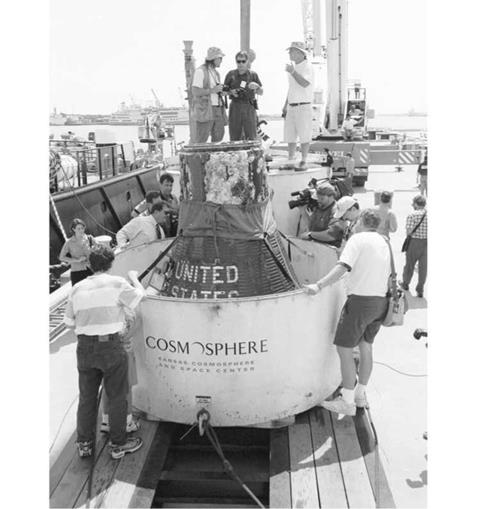A SPACECRAFT FINALLY LANDS
Following the spacecraft recovery, Newport and the Kansas Cosmosphere’s Max Ary began their documentation and post-recovery work. After taking photographs, Newport used a bilge pump to remove pooled water from the bottom of the capsule while Ary reached through the hatch to see what he could find. To their amazement he felt something unusual and upon withdrawing his hand from the muck revealed several shiny Mercury dimes.
To prevent further degradation and corrosion following the capsule’s exposure to the air, Liberty Bell 7 was placed into a specially designed container filled with sea water for shipment to the mainland – to a place not far from where it had ascended into the sky atop a Redstone rocket 38 years before. “Putting that capsule into the container at night, and at sea, was a harrowing experience. We had it in a cargo net and against my explicit instructions the crane operator slewed the capsule around over the sea off the port side with the ship rolling like crazy. I literally put my body between the capsule and the ship’s side to keep them from colliding and Liberty Bell 7 was dunked several times in the water to stabilize things. But we got it done and no one lost any fingers while installing the heavy container top.”23
As the Ocean Project neared Port Canaveral, Curt Newport called the recovery crew together and thanked them for their involvement in the incredibly successful mission – the deepest commercial salvage operation in history.
“I popped the cork on a magnum bottle of Moёt champagne and we celebrated as much as our one bottle allowed.”24
|
Once on board the Ocean Project, Liberty Bell 7 was placed in a special water tank to keep the spacecraft moist in the hot sun. (NASA-KSC, Photo ID KSC-99PP-1033) |











